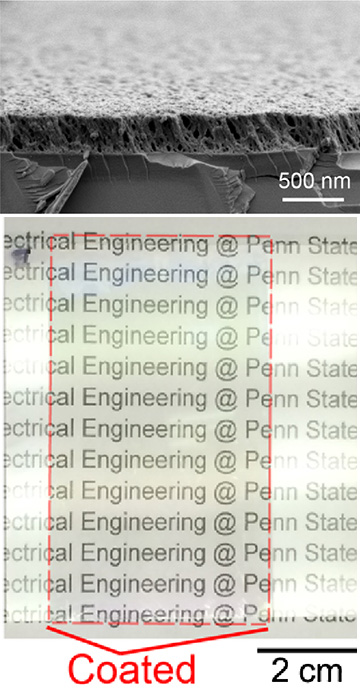
[Top] SEM image of a GLAD-deposited Teflon film. [BOTTOM] A bilayer coating, deposited on a Fresnel lens, materially improved transmittance. [Images: Wang et al., Optica, doi: 10.1364/OPTICA.4.000239]
Antireflection (AR) coatings have a long history in optics, in applications ranging from lenses to advanced imaging systems. But for plastic optics in certain applications, such as exterior solar concentrators, coming up with an AR coating tough enough to stand up to the challenges of harsh environments has proved a tricky proposition.
Now, a team at the Pennsylvania State University has reportedly developed a process for AR coatings on plastic that delivers broadband, wide-angle performance, and can stand up to environmental, mechanical and chemical stresses (Optica, doi: 10.1364/OPTICA.4.000239). The team believes that the method—a potentially good fit with standard commercial vacuum coating processes—could “find widespread use” in a range of plastic-optics applications.
GLAD tidings
The problems with AR coatings on plastic optics trace to the difficulty of developing a coating that can hang on tightly to the plastic, yet provide adequate performance across a wide range of incidence angles and wavelengths. AR coatings for plastic eyeglass lenses have been around for decades, but are limited to visible wavelengths and can be complex to apply. And broadband coatings developed for other optical materials don’t tend to play well with plastics, running aground on issues related to thermal-expansion mismatch and poor adhesion.
The Penn State team, led by OSA member Noel Giebink, worked to get around these limitations by combining a tough, commercially available coating, the fluoropolymer Teflon AF, with an evaporative-deposition technique that had scored success in creating coatings on non-plastic substrates such as SiO2 and MgF2. In the technique, glancing-angle deposition (GLAD), the substrate to be coated is positioned at an angle relative to the vapor flux of the coating material.
Previous research with GLAD had shown that the deposited layer’s refractive index varies with the angle of deposition. That opened up the possibility of a multilayer coating (with each layer deposited at a different angle) that could minimize reflections at a range of incidence angles. And Teflon had the potential for forming a strong and resistant chemical bond with the polymers in plastic optics.
Tough but sensitive
The team put these principles to work by laying down a two-layer graded-index coating, with the layers GLAD-deposited at two different incidence angles, onto polycarbonate and acrylic substrates. Even these simple bilayer coatings reduced reflectance, averaged across the solar spectrum, to less than 1 percent, across a roughly 40-degree range of incidence angles.
What’s more, the coatings could stand up to a lot of wear and tear. The team ran them through a range of insults including sharp pulls from adhesive tape, abrasion with cheesecloth, immersion in harsh chemicals and cycles of bending and compression, and found zero to negligible impact on AR performance. The team also found that combination of Teflon and GLAD produces a strongly hydrophobic surface, which gives the coatings good anti-fogging properties. And they were able to establish that the technique could work on curved and complex optical surfaces by applying and testing the bilayer coating on an f/1 curved lens and on acrylic Fresnel lenses.
Giebink characterizes the technique’s combination of broadband, wide-angle AR performance and extreme durability as “truly unprecedented for the industry.” And the team believes that the process could have wide application. While the study focused on two plastic-optics substrates in particular, the researchers suggest that the coatings could prove broadly applicable to other polymer materials, in view of the detailed polymer chemistry of the process, in which small fragments of the evaporated Teflon apparently diffuse into and repolymerize with other polymer chains in the substrate. And the actual deposition strategy appears to be “compatible with standard commercial vacuum coating systems,” according to the study.
